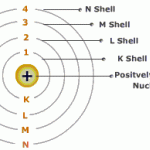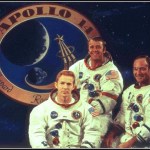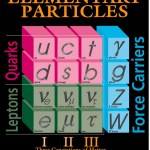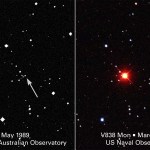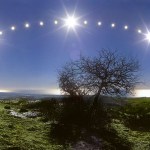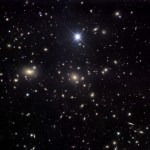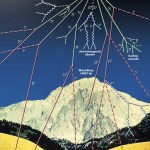Physics
On the way to get SteelyKid from day care last night, I flipped on ESPN radio in the vain hope of getting a baseball score, but wound up listening to former Mets manager and freelance jackass Bobby Valentine talking about how difficult batting is, which included the statement:
And the whole thing is over in a mega-second!
A mega-second, of course, is 1,000,000 seconds, or a bit less than twelve days. That's awfully long for an at-bat in baseball, though it might not be unreasonable for cricket.
Subsequent comments made clear that Valentine was trying for "millisecond," though it remains…
I'm shamelessly stealing this question from James Nicoll, who asked it about science fiction. The question is a play on the famous comment that only of order a thousand people bought the first Velvet Underground record, but every one of them went on to start a band.
So, the question is, who is the Velvet Underground of science? That is, who is the best example of somebody whose work was only read by a tiny number of people, but ended up being incredibly influential on those people and subsequent generations?
The physics example that comes to mind immediately is Sadi Carnot. Carnot wrote a…
Between travel and general work craziness, I completely forgot to note that the UK version of How to Teach Physics to Your Dog has gone on sale:
The title for this edition is How to Teach Quantum Physics to Your Dog, and the vanity search keeps turning up mentions to it in the Guardian Bookshop, so I guess they like their dog physics with extra quantum in Britain. Anyway, if you've been waiting and wondering when there would be a version with fewer idiomatic Americanisms, it's here, and available from the usual sources.
This brings the in-print edition tally to five, that I know of: the…
"Neutrinos, they are very small.
They have no charge and have no mass
And do not interact at all.
The earth is just a silly ball
To them, through which they simply pass,
Like dustmaids down a drafty hall
Or photons through a piece of glass." -John Updike
It was so much fun talking about neutrinos that I thought I'd take the time to tell you what all the fuss is about.
Let's go back -- way back -- to the late 1920s. Not only did we know that everything on Earth was made out of atoms, we knew that atoms were made out of atomic nuclei, which were positively charged, massive, and tiny, and…
The 2010 Nobel Prize in Physics goes to Geim and Novoselov for their work on graphene, a material consisting of one-atom-thick sheets of carbon atoms in a hexagonal array. This is one of those prizes that was basically inevitable, as graphene is one of the hot materials of the last couple of years. Hardly a week goes by without a couple of press releases touting some amazing new potential application.
Joerg Heber has a nice explanation of the basics of graphene, including some cautionary notes about overhype. From an experimentalist's perspective, the really cool thing about this prize is…
A quick check-in from Tuscaloosa, where we're getting ready to head out for the football tailgating. While I've got a minute, though, here are the slides from my public lecture, via SlideShare:
What Every Dog Should Know About Quantum Physics
View more presentations from Chad Orzel.
These are probably less comprehensible that some of my other talks, as I deliberately avoided putting much text on the slides, which I think works better for this kind of presentation. The down side, of course, is that it's not as obvious what some of the slides mean, if you don't know the intended flow of the…
Mission control: You need to bend your knees a little more. Keep your head down.
Alan Shepard: I'm... wearing a space suit.
Mission control: Just trying to help.
Apollo 14, the third crew ever to land on the Moon, pulled one of the most iconic stunts of all time.
Along with Stuart Roosa (left) and Edgar Mitchel (right), commander Alan Shepard (center) became the first man to golf on another planet.
His famous quote, after hitting the ball squarely, was:
Miles and miles and miles.
But take a look at the video itself. It sure doesn't seem like that ball would've gone miles and miles and miles…
I am in Alabama at the moment, the temporary owner of a ginormous Ford SUV and a hotel room that even I think is a little more air-conditioned than strictly necessary. Which means that it's time for the How to Teach Physics to Your Dog mini-tour of the Southland. On Wednesday, I'll be driving to and speaking at Berry College at 8pm, then on Thursday, I'll be driving across Alabama to speak at the University thereof at 7:30.
If you're within striking distance of either of those places, come on by and see the talk-- I've got an all-new public lecture for this trip, and I promise it will be…
"I know all about neutrinos, and my friend here knows about everything else in astrophysics." -John Bahcall
Neutrinos are the most poorly understood particles in the standard model. Remember the standard model?
The standard model of elementary particles tells us what the fundamental constituents of matter and forces are in our Universe. We have the force carriers -- photons, gluons, W's and Z's, and the Higgs -- that are responsible for every force in the Universe except gravity. We've got the six quarks (up, down, strange, charm, bottom, and top), that are responsible for the proton, the…
It's that time of year again-- the Swedes will be handing out money to famous scientists, with the announcements of who's getting what starting one week from today. Thus, the traditional Uncertain Principles Nobel Prize Picking Contest:
Leave a comment on this post predicting the winner(s) of one of this year's Nobel Prizes. Anyone who correctly picks both the field and the laureate will win a guest-post spot on this blog.
The usual terms and conditions apply. If you don't have anything you'd like to guest-post about, you can exchange your guest post for a signed copy of How to Teach Physics…
One of the things I've been stressed about lately is next week, when I'm making a trip to the South, specifically Georgia and Alabama. As I mentioned here earlier, the original inspiration was a get-together with friends from college for the Florida-Alabama football game next Saturday, but it seems a shame to go all that way and not do something book-related, so I have arranged to give four talks in two days. Two of these are research colloquia, but the other two are public lectures that might be of interest to readers of this blog or How to Teach Physics to Your Dog:
First, on Wednesday,…
"Nothing travels faster than light, with the possible exception of bad news, which follows its own rules." -Douglas Adams
Every once in a while, a star in our own galaxy can do something to surprise us. Over in the constellation of the Unicorn lived a quiet, run-of-the-mill star named V838 Monocerotis. But in early 2002, it brightened incredibly rapidly, and the before-and-after pictures were rather astonishing.
What was initially thought to be a nova turned out to be much, much more fascinating by time the Hubble Space telescope got around to looking at it in May of 2002.
Warning: what you'…
Got a big box in the mail today, which included author copies of two Asian editions: the Japanese edition, which I had seen before, and this:
That is, obviously, the Chinese edition of How to Teach Physics to Your Dog. I say "obviously" mostly because I know that edition was about ready to roll out-- I can't say anything about the actual characters on the cover, other than that they don't include any katakana, and thus it's not the Japanese edition, and they're not hangul characters, meaning it's not the Korean edition. Other than that, I got nothing.
If you can read Chinese, and provide a…
"I feel the earth move under my feet
I feel the sky tumbling down
I feel my heart start to trembling
Whenever you're around" -Carole King
I had so much fun earlier this week telling you about how we know that the heliocentric model is better than the geocentric one, that I thought I'd go a little farther down that rabbit-hole. You see, the first astronomical thing that any living creature likely notices is that, as seen from Earth, the Sun rises in the East each day and sets in the West.
(I don't want to hear it from you kids at the poles, either!)
The Sun, as it were, appears to move in…
"It doesn't matter what temperature the room is, it's always room temperature."
-Steven Wright
Far and away, one of the greatest things the Universe has ever created are dense clusters of galaxies!
The Coma Cluster, shown above, is a classic example of one of these colossal objects. (And as always, click on it for the huge version.) These giant clusters of galaxies contain over 1,000 galaxies that are Milky Way-sized or bigger, and span a few tens of millions of light years across space.
Compare that with our paltry local group of galaxies, where we have exactly two galaxies Milky Way-sized…
This guest post is written by BNL cosmologist Anže Slosar. Slosar, who joined Brookhaven's physics department in 2009, received his Ph.D. from Cambridge University in 2003. He previously worked at Lawrence Berkeley National Laboratory, Oxford University, and the University of Ljubljana in Slovenia.
Anže Slosar
Brookhaven Lab is involved in three cosmology experiments aimed at unraveling deep mysteries and inner workings of the universe. Two of these -- the Dark Energy Survey (DES) and Large Synoptic Survey Telescope (LSST) -- won't see "first light" (the beginning of commissioning)…
Not long ago, a new preprint on the fine structure constant got a bunch of press, nicely summed up by the Knight Science Journalism Tracker last week. I meant to say something about this last week, but what with it being the first week of classes and all, I didn't find the time.
I still think it's worth writing about, though, so after a reproduction of the key figure, we'll have the usual Q&A-format explanation of why I don't quite trust this result:
So what's this all about? The preprint in question is the latest in a series of attempts to measure possible changes in the fine structure…
Regarding this whole skeptic thing, if there's one thing I've learned about pseudoscience and bizarre, unscientific beliefs, it's that, just when I think I've seen it all, the world slaps me in the face (facepalm, to be precise) to show me that I haven't seen it all after all. Such was what happened when a truly bizarre conference started popping up around the skeptical blogosphere at blogs like Pharyngula, Unreasonable Faith, and Starts With A Bang. If you think that one thing that kooks can't deny is that the earth revolves around the sun, you'd be wrong. Witness the Galileo Was Wrong…
A fairly straightforward question: quantum physicists divide the world into two categories of things, fermions and bosons. What's your favorite object having integer spin?
What's your favorite boson?online survey
Superpositions of answers, while allowed in properly symmetrized wavefunctions, are not valid responses to this poll.
"Consideration of particle emission from black holes would seem to suggest that God not only plays dice, but also sometimes throws them where they cannot be seen." -Stephen Hawking
Last week, I wrote about how high-energy cosmic rays strike Earth's atmosphere and wind up bombarding everything on Earth's surface with super-fast moving particles, some of which are even unstable!
In passing, I mentioned that these cosmic rays (mostly protons) come from a variety of sources, such as the Sun, neutron stars, supernova remnants, the centers of galaxies, and (everyone's favorite) black holes.
(…
